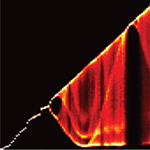Published/Posted: November 11, 2018
Authors: Hart, J. D.
DOI: 10.13016/jf05-uw3i
Abstract: In this thesis, we report work in two areas: synchronization in networks of coupled oscillators and the evaluation of physical random number generators. A ``chimera state'' is a dynamical pattern that occurs in a network of coupled identical oscillators when the symmetry of the oscillator population is spontaneously broken into coherent and incoherent parts. We report a study of chimera states and cluster synchronization in two different opto-electronic experiments. The first experiment is a traditional network of four opto-electronic oscillators coupled by optical fibers. We show that the stability of the observed chimera state can be determined using the same group-theoretical techniques recently developed for the study of cluster synchrony. We present three novel results: (i) chimera states can be experimentally observed in small networks, (ii) chimera states can be stable, and (iii) at least some types of chimera states (those with identically synchronized coherent regions) are closely related to cluster synchronization. The second experiment uses a single opto-electronic feedback loop to investigate the dynamics of oscillators coupled in large complex networks with arbitrary topology. Recent work has demonstrated that an opto-electronic feedback loop can be used to realize ring networks of coupled oscillators. We significantly extend these capabilities and implement networks with arbitrary topologies by using field programmable gate arrays (FPGAs) to design appropriate digital filters and time delays. With this system, we study (i) chimeras in a five-node globally-coupled network, (ii) synchronization of clusters that are not predicted by network symmetries, and (iii) optimal networks for cluster synchronization. The field of random number generation is currently undergoing a fundamental shift from relying solely on pseudo-random algorithms to employing physical entropy sources. The standard evaluation practices, which were designed for pseudo-random number generators, are ill-suited to quantify the entropy that underlies physical random number generation. We review the state of the art in the evaluation of physical random number generation and recommend a new paradigm: quantifying entropy generation and understanding the physical limits for harvesting entropy from sources of randomness. As an illustration of our recommendations, we evaluate three common optical entropy sources: single photon time-of-arrival detection, chaotic lasers, and amplified spontaneous emission.Citation:
J. D. Hart, "Experiments on networks of coupled opto-electronic oscillators and physical random number generators", PhD Physics, University of Maryland (2018)
Manuscript: Hart_PhD_Thesis_2018.pdf
